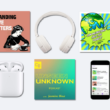You have probably heard of ChatGPT – it is hard not to come across it with the media coverage it has received lately.
ChatGPT stands for Generative Pre-trained Transformer. It is a language model that can understand and generate human-like text.
The history of ChatGPT dates back to 2018, when OpenAI, an artificial intelligence research laboratory, first introduced the model.
The original GPT was trained on a dataset of over 8 million text documents and could generate human-like text by predicting the next word in a given sentence. Since then, two new versions have been released.
GPT-3 was released in 2020 and is the most advanced version of the model to date. As a result, users can now employ it for many applications, including customer service, e-commerce, content creation, and branding.
Since we are a journal about branding, we’re going to explore in this article the application of ChatGPT in marketing and evaluate if it can already help brand marketers.
50 Video Lessons | In-Depth Workbook | Templates | Support
The Ultimate Brand Building System is now open for registration. Enroll today to stand out in your market and create a future-proof brand!
Table of Contents
Use cases of ChatGPT in marketing

Since the launch of ChatGPT from Open AI on November 30th, 2022, there has been hype around this novel tool, and businesses have been eagerly looking into ways to incorporate ChatGPT into their marketing mix.
Since ChatGPT is a Natural Language Processing (NLP) model and can analyze and understand text, speech, and other forms of human language, we selected several compelling use cases for strategic marketing.
Customer support
This use case of ChatGPT is in its name. Businesses can draw upon ChatGPT’s ability to communicate with their customers in an automated manner.
Integrating ChatGPT into their already existing messaging tools, the language model can understand and respond to customer questions and inquiries in a human-like manner. As ChatGPT’s replies are almost instantaneous, the response time compared to a human service agent is reduced.
Resolving fundamental service issues efficiently, ChatGPT can help to reduce the number of phone calls and free up customer service staff to focus on more complex support issues.
All in all, using ChatGPT in customer service can lead to a better service experience and increased customer satisfaction.
Customer insights
As discussed earlier, ChatGPT can understand, interpret, and generate human language. Business managers can therefore use it to analyze customer data and gain valuable customer insights.
One application is to conduct sentiment analysis. Here, ChatGPT can help analyze customer feedback, reviews, ratings, and social media comments to understand the prevailing feelings and opinions of your brand, product, or service.
ChatGPT can also thematically categorize all customer feedback you collect into topic clusters, such as what customers like about your product or service and the most critical areas for improvement.
Managers can then use this information to improve their value proposition and customer experience and ultimately adjust their branding strategy.
Planning and predictions
Once trained on historical customer data, ChatGPT can be used to make predictions about future customer behavior.
For example, by training ChatGPT on historical customer data, including demographic information, past transactions, and customer behavior data, it can predict which customers are likely to churn (i.e., cancel their service or stop using a product). The business can then proactively contact these clients and offer incentives or promotions to keep them as customers.
Identifying those future trends and patterns helps businesses make informed decisions about resource allocation and planning.
Personalized marketing communications
By analyzing customer data and feedback, ChatGPT can understand customer preferences and behavior and assist with creating personalized marketing messages.
Providing the model with data, such as past purchases, browsing history, language, and preferred communication channels, ChatGPT can create all kinds of highly targeted messages.
Examples include highly targeted social media ads, e-commerce email campaigns with personalized shopping recommendations, or a food delivery company’s chatbot that can recommend menu items based on a customer’s past orders and dietary preferences.
Overall, such personalized content is more likely to resonate with the target audience and can lead to higher customer engagement, more sales, increased customer loyalty, and higher brand awareness.
Content creation
Since ChatGPT is a language model trained on a large amount of text data, it can automatically generate high-quality, relevant, and engaging content.
ChatGPT is a very helpful tool for creating website content, including blog posts, homepage copy, or landing pages. The model makes it easy to explore topics, discover the keywords most likely to drive traffic to a site, structure texts, and even automate content creation based on your initial input. ChatGPT can also ensure that the content is consistent in tone, style, and messaging when collaborating with team members.
When operating an e-commerce business, ChatGPT can be used to generate product descriptions that resonate with your customers. The model can analyze customer behavior data and product reviews to determine the information consumers really want. It will then create descriptions optimized for search engines and most compelling to customers. In the same way, ChatGPT can also assist with creating marketing materials and ads.
Can ChatGPT be used for branding?

Now, the above-discussed applications in marketing, branding, and customer service are interesting. However, what if ChatGPT could replace brand managers and consultants entirely?
For this, it would need to fully understand essential concepts such as the target market, value proposition, and positioning of a given business.
Since we’re curious, we gave ChatGPT a few tasks that branding experts can confidently complete.
ChatGPT in action: Can ChatGPT create a logo?
The first task involved creating a logo for a café in Brooklyn, New York. Here’s ChatGPT’s answer:
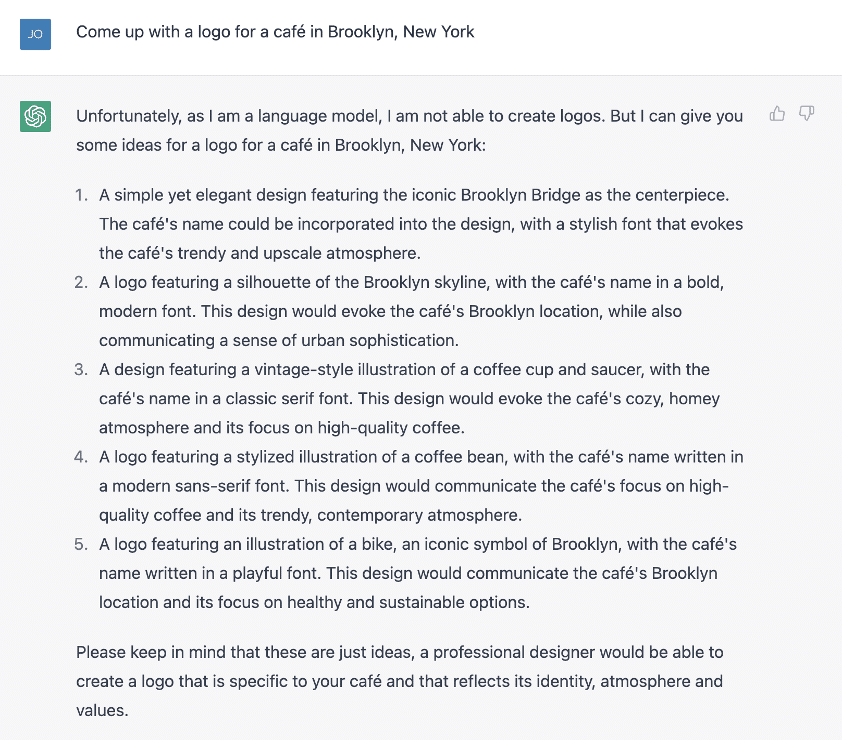
Now that’s an interesting answer.
ChatGPT understood well where the café would be located and proposed to feature some unique elements that it thinks could resonate well with customers in Brooklyn (a bike, Brooklyn’s skyline, Brooklyn Bridge). It also provided some font suggestions.
To compete with an expert logo designer, ChatGPT still needs more creativity and, most importantly, insights into the coffee industry in Brooklyn. Without the last part, developing a distinctive logo in a highly competitive market is almost impossible.
To be honest, we didn’t expect ChatGPT to actually design a logo – for this, we should have probably turned to OpenAI’s sister product, DALL·E 2. ChatGPT’s answer is, however, a good starting point and food for thought for an in-depth brainstorming session.
ChatGPT in action: Can ChatGPT come up with a complete branding strategy?
Now that’s a task! Let’s see if ChatGPT can create a sound branding strategy for our café in Brooklyn, New York. Here’s ChatGPT’s answer:

ChatGPT focussed its answer on providing users with actionable steps that the model thinks are necessary to build a brand. This is a good start.
We are missing, however, many essential steps that would lead to building a compelling brand.
Before defining the target audience, a thorough context analysis of the café would be necessary. This should include a definition of the business you are in (think about Starbucks’ famous third place concept), an overview of the competition in the market, and an identification of the opportunities and threats in the market and society (PESTEL). Once you have done this, you should create an overview of the market segments and then choose your target market(s).
Another issue with ChatGPT lies in its target audience. The suggestion to target young professionals and students that live in Brooklyn simultaneously as tourists that want to experience Brooklyn would require different branding approaches as their needs are different.
One vital step in developing a branding strategy is to think about the brand essence and core identity. This includes thinking about the brand purpose (why are you here?), vision (where do you want to be in 5-20 years?), mission (how do you plan to achieve your vision?), as well as values and guiding principles (what does your brand stand for?). Based on this and the content analysis, you would then draft a brand positioning, including your brand promise. ChatGPT refers to this entire step as “developing a unique value proposition,” which is far too general and misses essential considerations.
Another issue with ChatGPT is that it focuses on the visual identity. Yet, your brand’s identity includes much more than just the visible part. The name, personality, communication style, and sensory identity are things to consider.
ChatGPT’s ideas on how to communicate (including community engagement) and how to manage the brand are an excellent food for thought and definitely something that should be part of a branding strategy. That ChatGPT mentions “consistency” is also interesting and very much needed to align your entire company with your brand strategy.
A last factor that ChatGPT is missing is to measure and adjust your brand strategy as time passes.
Overall, ChatGPT provided a good starting point, yet the model needs to include more steps to help people really come up with a sound branding strategy.
ChatGPT in action: Can ChatGPT create a brand identity?
We wanted to know what would happen if we asked ChatGPT to focus on a specific part of a branding strategy.
In this case, we asked the model to create a brand identity for our café in Brooklyn, New York:
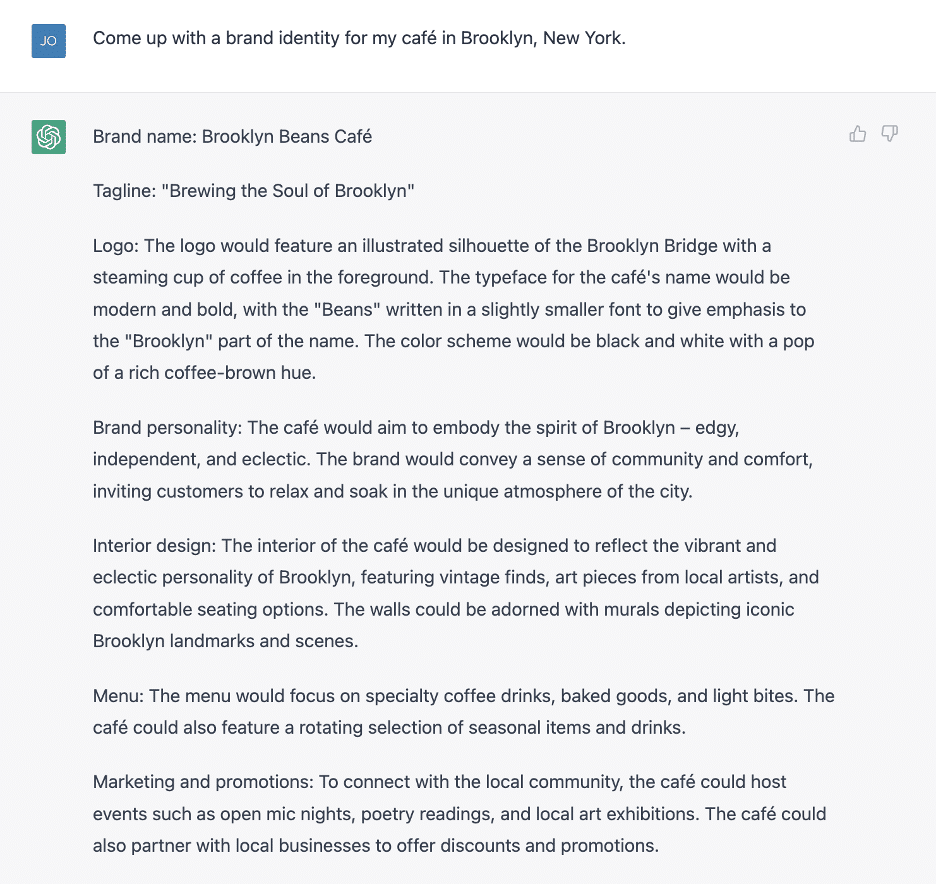
ChatGPT provides a compelling brand identity. It understands what a brand identity is and gives you directly, for each of the main aspects, an idea, and description.
As a starting point to explore the concept and get a basic understanding of it, ChatGPT’s output is highly constructive. You could even start a rather lovely café based on ChatGPT’s information.
What is still missing in the model is an insight into the exact target audience of your café. But then, we didn’t specify this in our prompt.
When added, the answer, unfortunately, solely focuses on “young professionals and students”, and ChatGPT completely ignores the fact that the café is located in Brooklyn:
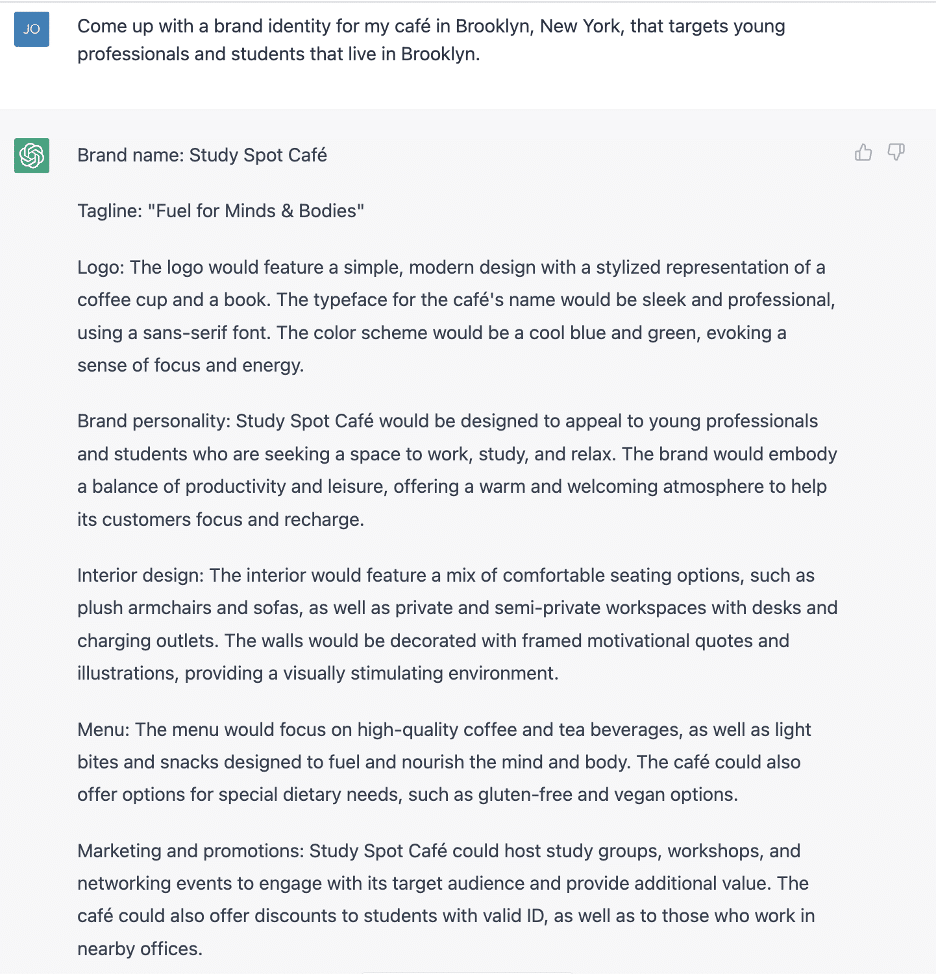
ChatGPT in action: Does ChatGPT know about the target audience of a specific brand?
To confirm that ChatGPT is very limited regarding target markets and market data in general, we asked the model to present us with the target audience of a well-known coffee shop in Brooklyn, New York.
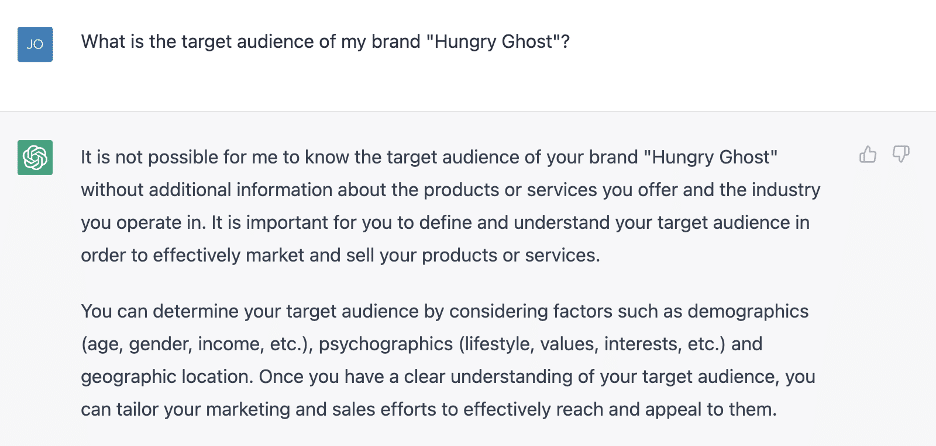
Even though “Hungry Ghost” is featured on many lists of the best coffee shops in Brooklyn (such as here, here, or here), ChatGPT does not know the brand and its target audience. It gives the searcher a general explanation of the term “target audience” and why it matters for businesses.
The same is the case when asking about the brand positioning of this particular coffee shop:

Challenges and considerations
As seen in the use cases, there is definitely some potential to apply the power of ChatGPT in marketing. Even though its use is still limited in branding, the model will be improved in the future, and more and more use cases for branding will become evident.
When adopting ChatGPT into day-to-day operations and strategic marketing, users and business owners will face challenges, and ethical and legal aspects must be considered.
The most prominent challenges and considerations of ChatGPT are the following:
- Data privacy: Companies must know the ethical and privacy implications of using large amounts of data to train ChatGPT. Concerns include data privacy laws as well as the handling of customer data. Businesses must obtain customer consent, have a clear privacy policy, and implement proper security measures to protect user data.
- Bias: Another factor to consider is the bias inherent in ChatGPT’s answers, as the model inherits all bias present in the data it was trained on. Marketers must be aware of this and should take appropriate actions (such as objectively revising the input data and double-checking ChatGPT’s output) to mitigate any potential biases in the model.
- Overreliance: As we’ve seen with our branding examples, ChatGPT cannot replace a brand consultant since it lacks market data and customer insights. It should, therefore, only be used in conjunction with the complete set of traditional marketing and branding techniques (e.g. focus groups, detailed analysis of market data, in-depth context analysis) and critically discussing strategy options. Businesses should not take the output of ChatGPT at face value.
- It is a machine: ChatGPT cannot replace the human touch that people bring to customer service and any other person-to-person interaction with the brand. Companies must strike a balance between using ChatGPT to enhance customer service and still keeping the human touch.
- Transparency: Transparency is crucial to client trust, and companies should clearly communicate to customers that they are using ChatGPT for data collection and analysis.
Conclusion
ChatGPT is already today a very helpful tool in business and marketing. When integrated into a company’s marketing toolbox, ChatGPT can bring the following benefits:
- Increased customer satisfaction
- Easier understanding of customers and target market
- Make data-driven decisions
- Improved brand awareness, drive sales and more effective campaigns (engagement)
ChatGPT comes, however, with many limitations when compared to the work of a human with expertise in branding.
As it cannot perform a thorough context analysis for a business, it lacks insights into the market and target customers. Even though ChatGPT comes up with interesting ideas and provides a good starting point for branding tasks, the output of ChatGPT remains rather general and cannot be applied 1:1 to building a brand.
Companies should also be aware of the potential challenges and considerations when implementing ChatGPT and should consider their ethical and privacy obligations. It is important to note that ChatGPT is constantly developing and will be improved over the coming weeks and months. It will be interesting to see how the application of the language learning model in branding will evolve over time.




